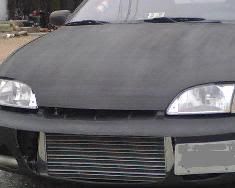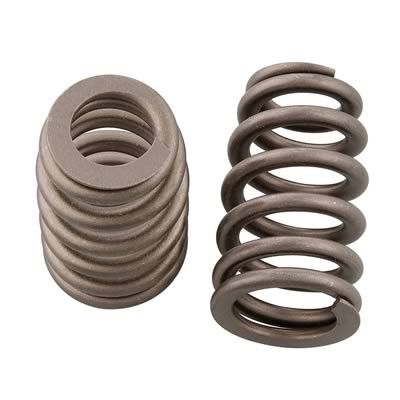Well, I know we've been discussing machining down the spring seats in the 2200 head and using the longer 2.2 valves in order to facilitate use of the popular and relatively inexpensive LSX style springs.... So I started doing some digging and almost the first thing to appear on my Google search was this article from ZZPerformance. They're a mostly 3800 shop, but the article definitely has some information that can pertain to the OHV community. Bear in mind, when referring to "stock retainers" the author is obviously talking about stock 3800 retainers, so don't get confused.
Valve springs and retainers
This tech article begins with an apology to those whom this offends and those who find out that they probably need to change the setup on their engines. If I sound harsh at times, it is because of the sheer amount of false information being presented by other companies. Their lack of research and sheer desire to profit from releasing products they haven’t researched has caused thousands of dollars in un-necessary damage to many engines.
For the 3800 there are a few choices of valve springs:
Stock –tested at ~70# pounds seat pressure @ install height of 1.72
LS1 –tested at ~70# seat pressure @ install height of 1.80
LS6 blue –tested at ~90# seat pressure @ install height of 1.80
LS6 yellow –tested at ~90# seat pressure @ install height of 1.80
Comp 105 –tested at ~108# seat pressure @ install height of 1.80
Comp 130 –tested at ~135# seat pressure @ install height of 1.80
Comp dual spring-tested at ~135# seat pressure @ install height of 1.80
Comp 150 -tested at 155# seat pressure @ install height of 1.90
Tested seat pressure is only at the seat, when the valve is closed. Our values are listed for springs that are brand new. When a spring is used, it will ‘settle’ to a slightly lower pressure. The seat pressure rating of the spring does not determine how much lift the spring can handle, what the open pressure will be or how “strong” the spring is (strength meaning resistance to breaking).
Spring rate determines how much pressure the spring will have when the valve is open. This is very important because the spring pressure when the valve is opening determines the force needed to open the valve. The more force needed, the higher the stress on the timing chain system. In our case, the stock timing chain dampener. This means that the higher the spring pressure during valve opening the more wear on the stock timing dampener.
The LS6 spring increases in pressure faster than the Comp 105 or the Comp 130 (which has the same spring rate as the 105). By the time you get to .300 lift, the yellow LS6 spring has passed the Comp105 in pressure. At valve lifts of .500 (close to what a 1.9 rocker gives) the LS6 spring is up to 275#, while the Comp105 is only 250# and the Comp130 280#.
Valve float is bad. The resistance to valve float is determined by the seat pressure, not the spring rate. For the 3800 running a stock timing dampener, it makes sense to try and run the seat pressure you need to prevent valve float, coupled with the lowest spring rate to reduce dampener wear. Valve float comes from the spring’s inability to control the valve. High rpm, fast ramp rates, valve lift, valve train component weight all play a factor in how soon your setup will experience valve float.
Performance: We recommend the Comp 105 spring over the LS6 spring because the 105 has a lower spring rate than the LS6. With a lower spring rate the dampener will not wear as fast. Another little known factor is rocker deflection. This is where the rocker actually bends as its being opened because of the massive force being applied to it by the spring. A stock rocker experiences this problem the worst and loses about 25 thousandths of valve lift due to deflection. This is the same as lowering the rocker ratio by .1 (turning a 1.9 into a 1.8 and so on). This is one of the reasons why HP gains from using high ratio rocker arms have been all over the spectrum. Using a modified 1.9 ratio rocker without changing the valve springs works well because the stock springs are light and you don’t get much rocker deflection. You do risk valve float this way but most people don’t have that problem. With a roller rocker you will get valve float with a 1.9 ratio rocker unless you use higher rate springs. This however costs you a small amount of lift and is why many people running 1.9 rollers, don’t see large gains over 1.8 ratio rollers using stock springs (which works w/o valve float). That certainly gives you a lot to think about but the bottom line is this: Using the Comp105s over the LS6 springs is a good idea if you don’t mind spending the extra money.
Retainers will determine your installed height. Using stock retainers gives you an installed height of 1.72 and using and LS1 or LS6 retainer (same part #) gives you an installed height of 1.80. If you use stock retainers with any of our LS1 style aftermarket springs, it will increase the seat pressure (by ~29# on an LS6, ~23# on a Comp105 or 130, and ~18# on a stock LS1 spring) This is because you are preloading the spring .080, so when you calculate total lift on the spring you have to add .080 to it. (Using stock 3800 retainer with LS6 spring and stock retainer with a .500 lift cam, compresses the spring as if you had a cam with .580 lift! There is no instance in which you should ever run stock 3800 retainers with an LS1 style spring meant for a 1.80 install height.
Maximum lift capability of a spring is not the same thing as coil bind. A spring has a rated maximum lift that is usually around 25 thousands lower than it’s coil bind point. Any vendor that gives you coil bind specs when you ask what lift is safe, does not have the knowledge to be giving advice.
Now that you know a little more about valve springs, we’ll explore the problems in the 3800 community.
Wbody store:
They sell a “light duty” valve spring. These have a dealer cost of less than $2/spring and come stock on an LS1. Its maximum rated lift is ~.500 and it does not have any more seat pressure than a stock 3800 valve spring. If you use it with stock 3800 retainers, the maximum lift drops to .420 (1.9 rockers bring the lift to .490). This spring should not be considered for use in our market.
Anyone using stock retainers with these springs can expect the spring to fail, using LS1 retainers and you have the same valve float protection as your stock springs.
This store rates the maximum lift of the Comp 105 as .590 and the Comp130s as .630, both are actually rated from Comp at .600 and coil bind around .625
Spring rates for their light duty and medium duty (LS1 and LS6) springs are incorrect.
Intense:
When they originally offered the “85 pound” springs, they used the blue LS6 springs. They have the same cost as the yellow but do not support the same lift. This shows a lack of testing and research. On the positive side, they now sell the yellow LS6 springs.
They currently list the LS6 spring for use with a stock retainer. This changes the maximum lift from .550 to .470. This also destroys the stock timing chain dampener in 5-10k miles when using 1.9 rockers or a small cam. They have this information listed on their site and on each box of springs send out. It is very, very bad information.
Intense springs package
Failed LS6 spring with stock retainer and 1.9 rocker
Failure pic2 with stock retainer and 1.9 rocker
Picture of a stock and damaged timing chain dampener when you have too much spring pressure
At ZZPerformance, we believe in testing products and doing all the research before releasing them on the public. That is why we have taken the time to work with Comp cams, educate ourselves, inspect engines that have been run under various conditions and share the information with you.
http://www.zzperformance.com/miscftp/spring%20testing01.jpg
http://www.zzperformance.com/miscftp/spring%20testing02.jpg
http://www.zzperformance.com/miscftp/spring%20testing03.jpg
http://www.zzperformance.com/miscftp/spring%20testing04.jpg
http://www.zzperformance.com/miscftp/spring%20testing05.jpg
http://www.zzperformance.com/miscftp/spring%20testing06.jpg
So, in considering that I think it was Notec who, many moons ago, bought the last double roller timing chain setup in the known universe for the OHV, it would seem from this article that going with the Comp 105 springs may be preferable to using the factory LS6 Yellow springs... Any comments? Ideas? Feel free to discuss....
As an aside, if anyone has one of those double roller setups that they're not going to use.... I'd be more than happy to take it off your hands

Arrival Blue 04 LS Sport
Eco
Turbo
Megasquirt
'Nuff said




















